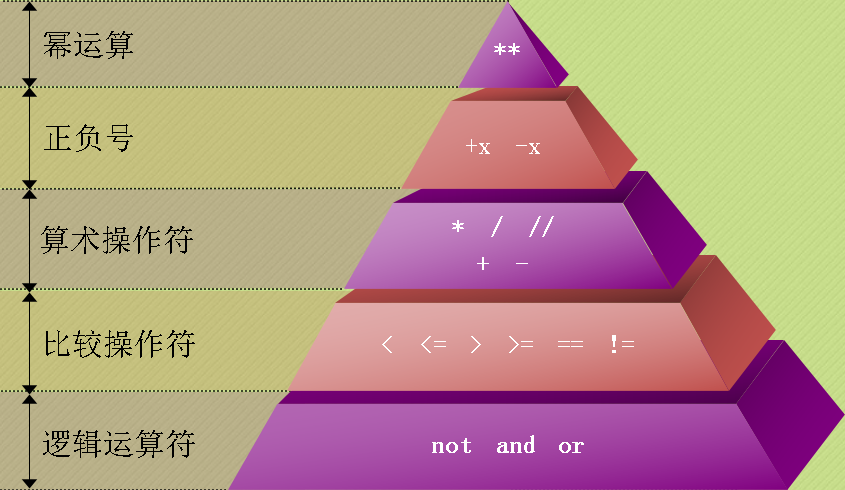--: 作者:不知百度知 2022年9月
[TOC]
## 1. if三元表达式(三元运算符)
### 1.1 说明
使用一行代码快速判断,更换复杂的多行if语句,使代码能够简单地维护。
### 1.2 其它语言的三元表达式
> 判段的条件 ? 条件为真时的结果:条件为假时的结果
```java
public class java {
public static void main(String[] args){
int x = 100;
int y = 101;
int MAX = (x > y)? x: y;
System.out.println("MAX:" + MAX);
}
}
```
### 1.2 python的三元表达式
> 条件为真时的结果 if 判段的条件 else 条件为假时的结果
```python
x = 4
y = 99 if x > 3 else 999
```
## 2. 变量的真假
在 Python 看来,只有变量的值为0或空、长度为0时,才会被看作假(注意引号、括号里边啥都没有,连空格都不要有!):
` False None 0 "" '' () [] {} `
其他一切都被解释为真!
测试示例:
```
if 0:
print('True1')
else:
print('False1')
if "":
print('True2')
else:
print('False2')
if []:
print('True3')
else:
print('False3')
if {}:
print('True4')
else:
print('False4')
if ():
print('True5')
else:
print('False5')
```
结果为
```
False1
False2
False3
False4
False5
```
所以我们经常会见到别人的代码这样判断
```
if 变量:
xxx
```
比如:
```
a = 10
if a: # a大于0,条件为真
a -= 1
else:
a = 10
```
## 3. 短路逻辑(short-circuit logic)
逻辑操作符有个有趣的特性:在不需要求值的时候不进行操作。
<div style='height:20px'></div>
这么说可能比较“高深”,举个例子,表达式 x and y ,需要 x 和 y 两个变量同时为真 (True) 的时候,结果才为真。
<div style='height:20px'></div>
因此,如果当 x 变量得知是假 (False) 的时候,表达式就会立刻返回 False ,而不用去管 y 变量的值。
这种行为被称为短路逻辑( short-circuit logic )或者惰性求值( lazy evaluation )。
<div style='height:20px'></div>
这种行为同样也应用于 or 操作符,Python 的做法是如果 x 为假,表达式会返回 x 的值 (0) ,否则它就会返回 y 的值。
```
a = 3 and 4 # 结果为4
b = 3 or 4 # 结果为3
```
## 4. 对象的类型判断
- type(对象) == 类型
- isinstance(对象, 类型)
python中type可以获得一个对象的数据类型,isinstance可以判断一个对象的数据类型,他们的区别有两点:
### 4.1. isinstance更加灵活
type只是返回一个对象的数据类型,而isinstance可以判断这个对象的数据类型是否为某几个数据类型中的一个。
假设我们要判断一个对象的数据类型是否为int或者float,两个函数的写法示例如下
~~~python
a = 4
# 使用type
if type(a) == int or type(a) == float:
print('yes')
# 使用isinstance
if isinstance(a, (int, float)):
print('yes')
~~~
显然,在这种场景下,isinstance更有优势
### 4.2. 判断存在继承关系的情况
~~~python
class A:
pass
class B(A):
pass
a = A()
b = B()
print(type(b) == A) # False
print(isinstance(b, A)) # True
~~~
B是A的子类, type(b)返回的是类B, 不等于A, 但B是A的子类,因此,我们可以认为b也是A的对象,面对这种存在继承关系的情况,应当使用isinstance。
官方推荐用第二种方法判断变量的类型,现在先有个初步印象,学到后面再作详细解释。
## 5. 运算符优先级
以下表格列出了从最高到最低优先级的所有运算符:
| 运算符 | 描述 |
| --- | --- |
| \*\* | 指数 (最高优先级) |
| ~ + - | 按位翻转, 一元加号和减号 (最后两个的方法名为 +@ 和 -@) |
| \* / % // | 乘,除,取模和取整除 |
| \+ - | 加法减法 |
| \>> << | 右移,左移运算符 |
| & | 位 'AND' |
| ^ | | 位运算符 |
| >= | 比较运算符 |
| <> == != | 等于运算符 |
| \= %= /= //= -= += \*= \*\*= | 赋值运算符 |
| is is not | 身份运算符 |
| in not in | 成员运算符 |
| not and or | 逻辑运算符 |
常见几种类型运算符优先级示意图

> 练习
- 请用最快速度说出答案: not 1 or 0 and 1 or 3 and 4 or 5 and 6 or 7 and 8 and 9
<div style='height:100px'></div>
not or and 的优先级是不同的: not > and > or,我们按照优先级给它们加上括号:
```
(not 1) or (0 and 1) or (3 and 4) or (5 and 6) or (7 and 8 and 9)
== 0 or 0 or 4 or 6 or 9
== 4
```
【Tip】
温馨提示:为了更好的表达你的程序,有些括号还是不能省下的,毕竟不是所有程序员都跟你一样都将优先级烂透于心的。
- 一、Python基础
- 1. 序言
- 1.1 Python简介
- 1.2 安装和使用IDE
- 1.3 语言特性和基础概念
- 2. 基本数据类型
- 2.2 字符串型
- 2.2.2 ASCII简介
- 2.2.4 字符串常用函数
- 3. 条件分支
- 3.3 闲聊条件判断和运算符优先级
- 10.正则表达式
- 【降龙十八章】Python小技巧
- 18.1 学习网址
- 18.2 PIP切换源
- 18.3 使用whl来安装
- 【工具优化】IDE优化技巧
- Anaconda
- Jupyter Notebook 的 Markdown 添加大纲
- Jupyter Notebook中图片缩放和居左
- Anaconda设置环境变量
- Pycharm
- PyCharm新建文档配置
- 设置字体和字号
- 设置主题和字体配色
- 保存和导入配置
- 设置对选择内容自动添加引号
- 推荐安装的插件
- Markdown
- 表格格式
- 二、Python进阶
- copy和deepcopy
- 《零基础入门学习 Python 》【小甲鱼版】
- 001.和Python的第一次接触+习题复习
- 002.用Python设计的第一个游戏 +习题复习
- Pygame详解
- Pygame详解:前言
- Pygame详解(一):Color类
- Pygame详解(二):display 模块
- Pygame详解(三):draw 模块
- Pygame详解(四):event 模块
- Pygame详解(五):font 模块
- Pygame详解(六):image 模块
- Pygame详解(七):key 模块
- Pygame详解(八):locals 模块
- Pygame详解(九):mixer 模块
- Pygame详解(十):mouse 模块
- Pygame详解(十一):Rect 对象
- Pygame详解(十二):Surface 对象
- Pygame详解(十三):time 模块
- Pygame详解(十四):music 模块
- Pygame详解(十五):pygame 模块
- Pygame详解(十六):cursors 模块
- Pygame详解(十七):joystick 模块
- Pygame详解(十八):mask 模块
- Pygame详解(二十一):BufferProxy 对象
- Pygame详解(二十三):gfxdraw 模块
- Pygame详解(二十五):Overlay 对象
- Pygame详解(二十八):sndarray 模块
- Pygame详解(三十一):camera 模块
- Pygame详解(三十二):cdrom 模块
- Pygame详解(三十六):version 模块
- pygame rect相关知识
- Tkinter详解
- Tkinter 组件详解(一):Label
- Tkinter 组件详解(二):Button
